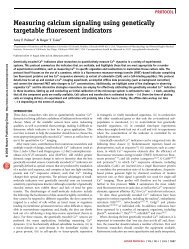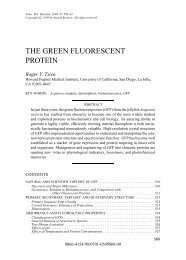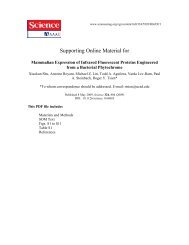Autofluorescent Proteins with Excitation in the Optical ... - Tsien
Autofluorescent Proteins with Excitation in the Optical ... - Tsien
Autofluorescent Proteins with Excitation in the Optical ... - Tsien
Create successful ePaper yourself
Turn your PDF publications into a flip-book with our unique Google optimized e-Paper software.
Chemistry & Biology<br />
Fluorescent <strong>Prote<strong>in</strong>s</strong> <strong>with</strong> Far-Red <strong>Excitation</strong><br />
Figure 1. Neptune Spectra and Sequence<br />
(A) Absorbance spectra of oxyhemoglob<strong>in</strong> (red), deoxyhemoglob<strong>in</strong> (dotted<br />
red), mKate (green dashed), mKate S158C (orange), mKate2 (dotted black),<br />
Neptune (dashed blue), and mNeptune (light blue). Units are M 1 cm 1 versus<br />
nm. Hemoglob<strong>in</strong> spectra are previously published (Stamatas et al., 2006).<br />
(Inset) Purified mCherry, mKate, S158C, and Neptune prote<strong>in</strong>s at 0.5 mg/ml<br />
<strong>in</strong> visible light.<br />
(B) Normalized excitation (left) and emission (right) spectra of mKate (green<br />
dashed), mKate S158C (orange), Neptune (dashed blue), and mNeptune (light<br />
blue). mKate2 excitation and emission spectra are identical to mKate, as<br />
described previously (Shcherbo et al., 2009).<br />
(C) Sequence of mNeptune aligned <strong>with</strong> its parent, mKate. Changes responsible<br />
for <strong>the</strong> red-shift are highlighted <strong>in</strong> red. The additional monomerization<br />
mutation to create mNeptune from Neptune is highlighted <strong>in</strong> green.<br />
Ser-158 to Cys or Ala improved <strong>the</strong> peak ext<strong>in</strong>ction coefficient of<br />
mKate (Figure 1A andTable 1). In <strong>the</strong> course of this work, mKate<br />
S158A (Pletnev et al., 2008) and its improved fold<strong>in</strong>g variant<br />
mKate2 (Shcherbo et al., 2009) were described. mKate and its<br />
S158A and S158C mutants all exhibit residual green fluorescent<br />
components (Figure S2A). While TagRFP (Shaner et al., 2008),<br />
TagRFP-T (Shaner et al., 2008), mKate, and mKate S158A<br />
(Figure S2A) bleached <strong>with</strong> complex k<strong>in</strong>etics, mKate S158C<br />
bleached <strong>in</strong> a monoexponential manner <strong>with</strong> a normalized halflife<br />
of 220 s, mak<strong>in</strong>g it <strong>the</strong> most photostable fluorescent prote<strong>in</strong><br />
<strong>with</strong> monoexponential photobleach<strong>in</strong>g. This rare attribute makes<br />
mKate S158C well suited for quantitative time-lapse experiments.<br />
We next attempted to fur<strong>the</strong>r red-shift mKate S158C by adopt<strong>in</strong>g<br />
<strong>the</strong> mechanism of emission red-shift<strong>in</strong>g <strong>in</strong> mPlum. In mPlum,<br />
Glu-13 hydrogen bonds to <strong>the</strong> term<strong>in</strong>al carbonyl of <strong>the</strong> conjugated<br />
bond system of <strong>the</strong> chromophore, but <strong>the</strong> <strong>in</strong>teraction is<br />
dependent on chromophore excitation and <strong>the</strong>refore primarily<br />
affects <strong>the</strong> emission spectrum (Abbyad et al., 2007; Shu et al.,<br />
2009b). We hypo<strong>the</strong>sized that a stable hydrogen bond<strong>in</strong>g <strong>in</strong>teraction<br />
<strong>with</strong> <strong>the</strong> term<strong>in</strong>al carbonyl <strong>in</strong> <strong>the</strong> ground state could cause<br />
a red-shift <strong>in</strong> excitation as well. Screen<strong>in</strong>g of libraries <strong>with</strong> all<br />
possible substitutions at position 13 and nearby positions 28,<br />
41, and 65, which are not conserved between mKate and<br />
mPlum, did not recover an obvious hydrogen bond donor at<br />
one of <strong>the</strong>se positions. However, we found that mutation of<br />
Met-41 to Gly alone resulted <strong>in</strong> red-shifted excitation and emission<br />
(Table 1). Two rounds of random mutagenesis by errorprone<br />
PCR <strong>the</strong>n yielded Y194F and S61C mutations, result<strong>in</strong>g<br />
<strong>in</strong> a prote<strong>in</strong> <strong>with</strong> 600 nm excitation and 650 nm emission<br />
(Figure 1B and Table 1). Because this prote<strong>in</strong> (mKate M41G<br />
S61C S158C Y194F; Figure 1C) looks blue <strong>in</strong> ambient light<strong>in</strong>g<br />
(Figure 1A) and has fluorescence wavelengths fur<strong>the</strong>st away<br />
from our start<strong>in</strong>g po<strong>in</strong>t among mKate derivatives, we named it<br />
Neptune.<br />
Neptune is <strong>the</strong> first bright fluorescent prote<strong>in</strong> (ext<strong>in</strong>ction coefficient<br />
72,000 M 1 cm 1 , quantum yield 0.18) <strong>with</strong> an excitation<br />
peak reach<strong>in</strong>g 600 nm. Compared to its parent, mKate, its<br />
absorption and excitation peaks are 18 nm redder (600 versus<br />
582 nm) and its peak ext<strong>in</strong>ction coefficient 71% larger (72,000<br />
versus 42,000 M 1 cm 1 ), result<strong>in</strong>g <strong>in</strong> more efficient excitation<br />
beyond 600 nm (Figure 1A and Table 1). Neptune exhibits a photobleach<strong>in</strong>g<br />
half-life longer than EGFP (Figure S2A), a pKa of 5.8,<br />
and fast maturation (half-maximal <strong>in</strong> 35 m<strong>in</strong>; Figure S2C). Like<br />
mKate and <strong>the</strong> brighter mKate S158A and S158C variants,<br />
Neptune shows a residual green component upon excitation at<br />
470 nm (Figure S2C).<br />
Visualization of Neptune <strong>in</strong> Cells and Deep<br />
Tissues of Liv<strong>in</strong>g Mammals<br />
Compared to previous fluorescent prote<strong>in</strong>s, Neptune has <strong>the</strong><br />
largest ext<strong>in</strong>ction coefficient at 633 nm, a wavelength well <strong>with</strong><strong>in</strong><br />
<strong>the</strong> optical w<strong>in</strong>dow and a common laser l<strong>in</strong>e used for excit<strong>in</strong>g<br />
<strong>the</strong> organic fluorophore Cy5 (Figure 1A and Table 1). We tested<br />
<strong>the</strong> ability to detect Neptune or mKate <strong>in</strong> cells <strong>with</strong> 633 nm excitation.<br />
Neptune was well detected <strong>in</strong> liver sections follow<strong>in</strong>g<br />
adenovirus-mediated gene transfer <strong>in</strong> mice (Figure 2A) <strong>with</strong><br />
532 or 633 nm laser excitation, while mKate was only detected<br />
above background <strong>with</strong> <strong>the</strong> 532 nm laser (Figure 2B). Thus <strong>the</strong><br />
bathochromic shift of Neptune relative to its parent mKate has<br />
conferred improved excitability at 633 nm, well <strong>with</strong><strong>in</strong> <strong>the</strong> optical<br />
w<strong>in</strong>dow.<br />
The ability to be excited at 630 nm makes Neptune potentially<br />
suitable for fluorescence imag<strong>in</strong>g <strong>in</strong> liv<strong>in</strong>g mammals us<strong>in</strong>g<br />
exist<strong>in</strong>g Cy5 filter sets. The liver <strong>in</strong> particular is a heavily vascularized<br />
organ where hemoglob<strong>in</strong> absorbance h<strong>in</strong>ders imag<strong>in</strong>g<br />
(Col<strong>in</strong> et al., 2000). Us<strong>in</strong>g an available Cy5 filter set (610–630<br />
nm excitation, 660–700 nm emission), Neptune fluorescence <strong>in</strong><br />
livers of liv<strong>in</strong>g mice follow<strong>in</strong>g adenovirus-mediated gene transfer<br />
was easily visible, <strong>with</strong> <strong>the</strong> brightest areas display<strong>in</strong>g 44-fold<br />
contrast over un<strong>in</strong>fected tissue autofluorescence (Figure 2C).<br />
We recently eng<strong>in</strong>eered a bacterial phytochrome <strong>in</strong>to a biliverd<strong>in</strong>-dependent<br />
<strong>in</strong>frared fluorescent prote<strong>in</strong>, IFP1.1, <strong>with</strong> excitation<br />
and emission maxima at 660 nm and 700 nm (Shu et al.,<br />
2009a). To see whe<strong>the</strong>r Neptune could be visualized orthogonally<br />
to IFP1.1, we imaged liv<strong>in</strong>g mice express<strong>in</strong>g ei<strong>the</strong>r Neptune<br />
or IFP1.1, us<strong>in</strong>g filter sets separately optimized for Cy5 (far-red<br />
Chemistry & Biology 16, 1169–1179, November 25, 2009 ª2009 Elsevier Ltd All rights reserved 1171






